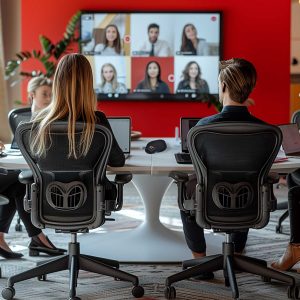The 4 key factors for professional quality sound video conferencing
After the imposition of teleworking in many of the companies in our country, the importance of the sound quality of video calls has become one of the most frequent concerns among employees. Therefore, if for you and your business videoconferencing is essential and you do not want to risk giving a bad image stay with us in this post.
In a professional videoconference, you can not allow the sound to detract from the online meetings of your business and much less transmit a bad image. Therefore, join us in this post and discover the 4 factors that will make the difference between getting a professional sound or a poor sound.
1. The space or environment: reduce the echo in the sound of your videoconferences.
The size of the room is essential to decide the type of microphone. Some spaces without any type of decoration tend to create sound reverberation, this because the sound travels without any containment to the walls generating a bouncing effect that distorts the voice. If the reverberation is very high, very annoying echoes can be produced.
However, even with professional equipment it is advisable to follow certain tips for the ambience of a videoconferencing room. Undoubtedly, the incorporation of certain decorative elements will contribute to better sound quality. Here are some tips for the videoconferencing environment:
- Avoid the existence inside the room of elements that generate too much noise, such as loud air conditioners, refrigerators or spaces close to noisy avenues. If it is unavoidable that the videoconference room is located on a main avenue, we recommend having compact windows with good sealing when closing.
- Decorate the room with elements that absorb the reverberation that causes the so-called video call noise. Try to use soft materials and objects that help in this noise absorption. For the floor, for example, the use of carpeting or rugs will help a lot in absorbing the reverberation of your room.
- Try to use decorative elements for the room. A "bare" room will result in higher reverberation during our calls. Objects such as potted plants or curtains are often a good complement.
- Use ceilings with sound-absorbing boards. Thanks to the use of these planks, the sound will be muffled by the "sponginess" of this type of ceilings. In addition, you can play with the colors and shapes of your planks to give a personal touch to your conference room.
2. The size of the videoconferencing room.
The previous point is extremely important for the decoration of your rooms. Although it is also necessary to take into account the size of the room. A small room usually has less acoustic problems than a large room.
For example, in a small room a single Laia t-Pod Wifi or a Laia t-Pod Trio with its three-in-one function (handsfree, VoIP phone and a videoconferencing terminal) will be more than enough to cover the sound of the entire room. In addition, it should be remembered that all our audio equipment has digital noise reduction, so acoustic echo cancellation will be a very positive factor so take into account our microphones.
On the other hand, if you have a large meeting room, a single Laia t-Pod Wifi or Laia t-Pod Trio may not be enough to pick up all the sounds in the room. In this case, options such as the Laia t-Pod Dual or Laia t-Pod Quad are usually more complete solutions.
In addition, we highlight one of the latest additions to the Laia microphone family: the Laia t-Pod Beamforming. A terminal with Beamforming technology with which you can manage the radio frequency signal through an access point that uses multiple antennas to transmit the same signal.
Perfect for picking up all sounds in medium to large meeting rooms thanks to its array of 12 internal unidirectional microphones. Or if you are looking for a quality audio solution built into the room you can opt for the Laia t-Pod Air Pro: the 360º omnidirectional ceiling microphone.
3. Increase the frequency range
The example commonly used to explain this is that of traditional telephones. This type of device limits its frequency range to one third of the voice range. This means that much of our speech can be lost during the meeting.
What we must do is to get equipment that increases this frequency range to try to identify all the speakers, which leads to better communication and understanding during your meetings. That is why this type of equipment should extend this frequency from 20HZ to 20000Hz, which corresponds to the range of the human ear.
4. Sound distribution
In order to explain this point, we must review what was said in the first point of this post: the size of the rooms. In this first point we alluded to how important it is to know what type of room we have. A large meeting room, for example, will require a series of technical equipment that, for a small meeting room, would be unnecessary. An example of this is external loudspeakers.
For a small meeting room, the simple audio from the monitor we are interacting with may be sufficient. But, for a medium or large meeting room, it may be necessary to include some type of external loudspeaker in our meetings. Thanks to this type of terminals, the audio will be distributed in a correct way in all the spaces of the meeting room, thus reaching all the interlocutors of the same one.
But to have optimal audio quality in each and every place in the room you do not need to make an economic outlay of speakers. Laia's family of professional microphones knows this, so most of its microphones are, in turn, microphones and speakers. This way you can listen and collect information from different parts of the meeting room.
For more information about audio or video conferencing solutions, please contact us.




